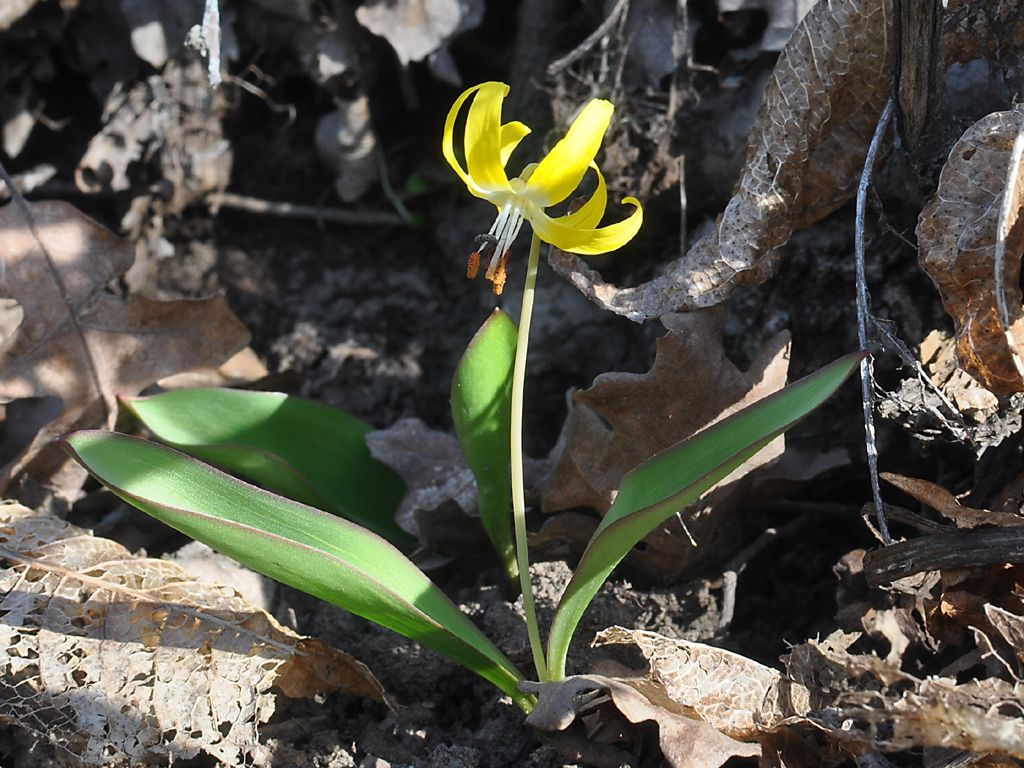
|
Family: Liliaceae |
Herbs, perennial, scapose, from ovate to elongate bulbs, sometimes with small, beadlike segments of short, persistent rhizome attached; several species producing additional bulbs as sessile bulbels or at the ends of slender stolons or vertical droppers, these species typically flowering more sparingly than those without extensive vegetative reproduction. Leaves 2 (1 in nonflowering plants), basal, ± petiolate; blade green or mottled with purple, brown, or white, lanceolate to ovate (wider if solitary), flat to folded, 6-60 cm, glaucous in a few species, glabrous, base narrowed gradually or abruptly to petiole, margins entire or sometimes wavy. Scape green or sometimes reddish, typically elongating in fruit. Inflorescences terminal, racemose, 1-10-flowered. Flowers showy, usually nodding, sometimes held laterally or erect; tepals 6 (as few as 4 in E. propullans), spreading to reflexed, distinct, similar, white, yellow, pink, or violet, often with basal zone of yellow or other colors, lanceolate to ovate, inner tepals auriculate at base in many species, auricles appressed to ovary and forming sac- or pocketlike hollows on adaxial surfaces; stamens 6; filaments generally slender; ovary superior; style 1, abruptly attached to ovary (or forming a beak in E. rostratum); stigma unlobed or 3-lobed, lobes recurved to erect. Fruits capsular, erect, obovoid to oblong, apex rounded, truncate, or umbilicate (beaked in E. rostratum), dehiscence loculicidal. Seeds brown, ± angular, ± ovoid. x = 11, 12. Erythronium is a well-marked and distinctive genus closely related to Tulipa. In North America, Erythronium consists of distinct eastern and western groups, the former clearly having an affinity with species of the Old World. Most of the species have attractive and showy flowers, and several are well suited for naturalizing in woodland gardens. Pressed specimens tend to fade, so leaf and flower colors and markings should be recorded on specimen labels at the time of collection. The orientation of flowers and fruits should also be recorded, and it is useful to collect bulbs of both flowering and nonflowering plants when this will not damage a population. Bulbs of Erythronium species are often more than 10 cm deep. Collectors should press flowers so that the shape of the style, stigmas, filaments, and petal bases can be observed later. Species of western North America (Rocky Mountains westward) and eastern North America (Great Plains eastward) seem to form two discrete evolutionary groups, and this geographic distinction is the first character used in the taxonomic key. Most western species can at least occasionally produce plants with multiple-flowered scapes, while eastern species always have a single flower. Bulbs of western species vary from ovoid to slender and elongate, while all eastern species have ovoid bulbs. Fruits of western species vary from obovoid to narrowly oblong, while all eastern species have obovoid fruits. In species with mottled leaves, the pattern of mottling in eastern species is a more or less random dappling (resembling that of the Eurasian Erythronium dens-canis), while in western species it takes the form of elongate lateral streaks or veining, often more or less symmetrical on either side of the midline. Several eastern species, but only a single western species (E. multiscapideum), propagate vegetatively by stolons originating largely from nonflowering bulbs. (The term 'stolon' is used here to refer to the slender, white, elongate, underground structures found in Erythronium.) In E. propullans, one stolon per plant is produced from the flowering scape below ground level. In species with stolons, populations often contain relatively few flowering plants. In the following descriptions, measurements of bulbs and leaves refer to flowering plants. The base chromosome number in Erythronium is x = 12, except for the white-flowered species of eastern North America, E. albidum, E. mesochoreum, and E. propullans, which have x = 11. Both diploid and tetraploid species occur with each base chromosome number (2n = 22, 24, 44, and 48). Although the pollination biology of most species of Erythronium is not well known, that of the bumblebee-pollinated E. grandiflorum has been the subject of extensive study (e.g., J. D. Thomson and D. A. Stratton 1985; J. D. Thomson and B. A. Thomson 1989). The oligolectic bee Andrena erythronii is associated with Erythronium in northeastern North America, although A. erythronii visits other species of plants, and other insects also visit Erythronium (P. Bernhardt 1977; W. E. LaBerge 1987).
Tep (4-)6, lanceolate, separate to the base but connivent, at anthesis spreading and usually eventually recurved; stamens 6; filaments elongate, flattened below; anthers linear-oblong, basifixed; ovules several to many; style slender below, usually thickened above to the 3 short stigmas; fr an obovoid to oblong loculicidal capsule; perennial from a deep solid corm, the slender stem about half subterranean; lvs borne near the middle of the stem and therefore appearing basal, usually mottled with brown, lanceolate to oblanceolate or elliptic. 15, all N. Amer. except E. dens-canis L., the European dog-tooth violet, with narrow, tapering, violet tep. Gleason, Henry A. & Cronquist, Arthur J. 1991. Manual of vascular plants of northeastern United States and adjacent Canada. lxxv + 910 pp. ©The New York Botanical Garden. All rights reserved. Used by permission. |
This project was made possible in part by the Institute of Museum and Library Services [MG-70-19-0057-19].
Powered by Symbiota



